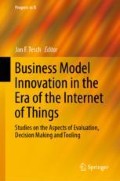Abstract
This chapter summarizes limitations and avenues on future research on IoT business model innovation.
Access this chapter
Tax calculation will be finalised at checkout
Purchases are for personal use only
References
Abdelkafi, N., Makhotin, S., & Posselt, T. (2013). Business model innovations for electric mobility—What can be learned from existing business model patterns? International Journal of Innovation Management, 17(1), 1–41.
Ali, A. (2015). An MCDM approach towards M-payment business models evaluation. International Journal of the Analytic Hierarchy Process, 7(2), 273–294.
Amshoff, B., Dülme, C., Echterfeld, J., & Gausemeier, J. (2015). Business model patterns for disruptive technologies. International Journal of Innovation Management, 1–22.
de Reuver, M., Bouwman, H., & Haaker, T. (2013). Business model roadmapping: A practical approach to come from an existing to a desired business model. International Journal of Innovation Management, 17(01), 1–18.
Desyllas, P., & Sako, M. (2013). Profiting from business model innovation: Evidence from pay-as-you-drive auto insurance. Research Policy, 42(1), 101–116.
Gassmann, O., Frankenberger, K., & Csik, M. (2014). The business model navigator: 55 models that will revolutionise your business. Harlow, UK: Pearson.
Gregor, S., & Hevner, A. (2013). Positioning and presenting design science research for maximum impact. Management Information Systems Quarterly, 37(2), 337–355.
Haaker, T., Bouwman, H., Janssen, W., & de Reuver, M. (2017). Business model stress testing: A practical approach to test the robustness of a business model. Futures, 89, 14–25.
Hevner, A. R., March, S. T., Park, J., & Ram, S. (2004). Design science in information systems research. MIS Quarterly: Management Information Systems, 28(1), 75–105.
Iivari, J., & Venable, J. R. (2009). Action research and design science research—Seemingly similar but decisively dissimilar. In ECIS 2009 Proceedings, No. Paper 73.
Nickerson, R. C., Varshney, U., & Muntermann, J. (2013). A method for taxonomy development and its application in information systems. European Journal of Information Systems, 22(3), 336–359.
Osterwalder, A., & Pigneur, Y. (2013). Designing business models and similar strategic objects: The contribution of IS. Journal of the Association for Information Systems, 14(5), 237.
Schneider, S., & Spieth, P. (2013). Business model innovation. Towards an integrated future research agenda. International Journal of Innovation Management, 17(01), 1–35.
Sein, M. K., Henfridsson, O., Purao, S., Rossi, M., & Lindgren, R. (2011). Action design research. MIS Quarterly, 35(1), 37–56.
Tesch, J.F. (2016). Discovering the role of scenario planning as an evaluation methodology for business models in the era of the internet of things (IoT). In Proceedings of the Twenty-Fourth European Conference on Information Systems (ECIS), Vol. 24, pp. 1–25.
Webster, J., & Watson, R. T. (2002). Analyzing the past to prepare for the future: Writing a literature review. Management Information Systems Quarterly, 26(2), 13–23.
Wynn, D., Jr., & Williams, C. K. (2012). Principles for conducting critical realist case study research in information systems. MIS Quarterly, 36(3), 787–810.
Yin, R. K. (1989). Research design issues in using the case study method to study management information systems. The Information Systems Research Challenge: Qualitative Research Methods, 1, 1–6.
Author information
Authors and Affiliations
Corresponding author
Editor information
Editors and Affiliations
Rights and permissions
Copyright information
© 2019 Springer Nature Switzerland AG
About this chapter
Cite this chapter
Tesch, J.F. (2019). Concluding Remarks. In: Tesch, J. (eds) Business Model Innovation in the Era of the Internet of Things. Progress in IS. Springer, Cham. https://doi.org/10.1007/978-3-319-98723-1_12
Download citation
DOI: https://doi.org/10.1007/978-3-319-98723-1_12
Published:
Publisher Name: Springer, Cham
Print ISBN: 978-3-319-98722-4
Online ISBN: 978-3-319-98723-1
eBook Packages: Business and ManagementBusiness and Management (R0)

